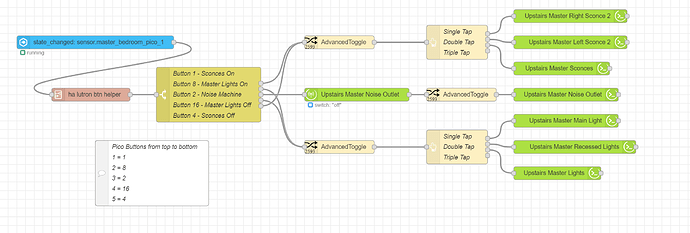Wanted to give everyone a simple example that just happened of why this setup could be beneficial but also is problematic for the folks who don't have a technical background or are not interested in tinkering. Apologies on the extra long post.. All my lights/switches are in HE and are being controlled via Node-RED.
In Node-RED I have a subflow I call "Button Taps", a subflow is kind of like a function, it contains your custom sequences and can be deployed like a regular node - very handy. I am using this to control our master bedroom sconces and our master bedroom lighting using 2 picos. I have one pico and my wife has the other. I set up some sequences that allow me to single tap control the sconce on my side of the bed, double tap to control the sconce on my wife's side. My wife's is set to do her sconce with a single tap and mine with a double.. you get the idea. By triple tapping either pico both sconces turn on/off depending on the button pressed. This has been working really well.
above: My original sequence, green nodes are HE devices, the pico is disabled due to it now running in HA/NR
After the most recent HE update, there was a new "double-tap" capability added to the Lutron app. Now picos could fire a double-tap event as necessary. This is a nice feature that unfortunately broke my Button Tap subflow. Turns out that triple or quadruple tapping only fires a double-tap event. There also seems to be a weird issue in detecting the double-tap event in my subflow for some reason - did not look into it but is probably a bug as it is supposed to handle double-tap events.
Nevertheless I needed to do something as PAF (Partner Approval Factor) was dropping fast.. noticed Home Assistant had a Lutron integration so decided to give that a whirl. Was able to pair HA to my Lutron bridge but unfortunately while the switches showed up, the picos as entities did not. That meant I could not use my pico stuff in Node-RED like I needed to. This was a bust... did some searching and found an alternative - a custom integration by "upsert" for the lutron-caseta-pro. Unfortunately we now get to the why HA is not really for non/light-technical people. Had to do some lower level setup - including copying directories, editing HA's dreaded "configuration.yaml", getting erros + a bunch of restarts. Finally got it to work and then imported and tweaked my Node-RED sequences from my main instance. Had to create a simple helper subflow to adjust the output to what my sequence was expecting but no big deal. Also made some minor improvements etc.
above: blue node is an HA "entity", green nodes are HE devices
In summary - was not planning on doing this but sometimes stuff happens and you need to figure out workarounds. Thanks to the additional capabilities of HA was able to keep everything running smoothly. Things are working great so far and the picos are very responsive - very much like they were in HE.
The main trouble with HA has always been figuring out how to do things if they aren't a standard part of the system and if you encounter problems, trying to fix them without causing more issues which then can become a nightmarish quagmire. The learning curve is steep and there is a lot of complexity just underneath the hood.
This is why I usually recommend sticking with straight HE or my favorite - the HE/NR combo.



